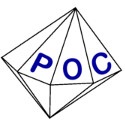|
Location Le séminaire aura lieu sur le campus de La Défense de l'ESSEC Business School. Adresse : Bâtiment CNIT, ESSEC Executive Education, Pl. de la Défense (92800, Puteaux) Room: Amphi 103 À propos du séminaire Le groupe POC (Polyhèdres et Optimisation Combinatoire) est un groupe de recherche transversal à différents laboratoires de recherche français (LAMSADE, LIMOS, LIPN, ESSEC, etc.) qui accueille des universitaires mais aussi des collègues d'entreprises (comme Orange et EDF) réunis par le intérêt pour les aspects polyédriques (à la fois théoriques et algorithmiques) des problèmes d'optimisation combinatoire. Le groupe organise deux séminaires par an (SPOC) sur des sujets complémentaires aux thématiques du groupe, ainsi que JPOC et ISCO. Le sujet de cette édition du SPOC est « Recent progress and interesting facts about the Simplex Algorithm » et comprendra les exposés de certains experts éminents dans le domaine tels que :
Même après plus de 50 ans, l’algorithme du Simplexe reste un sujet de grand intérêt. Nos conférenciers partageront leurs idées, leurs découvertes récentes et leurs perspectives sur cet algorithme. La veille, l'après-midi du jeudi 14 décembre, de 14h à 18h, nous avons le plaisir d'annoncer une rencontre "hors les murs" du groupe POC, toujours sur le campus de l'ESSEC à la Défense. Cette demi-journée est dédiée aux exposés de doctorants et de jeunes docteurs autour des thématiques d'optimisation combinatoire, en particulier celles liées aux thèmes du groupe POC. Cette opportunité est conçue pour présenter les travaux actuels des étudiants, ainsi que leurs sujets de recherche, dans un contexte informel. Pour tous ceux qui souhaitent être présents à cette occasion en qualité de spectateur ou de conférencier, merci de nous en informer via le formulaire d'inscription ci-dessous. Les conférenciers sont également priés de nous envoyer un courriel à spoc27@sciencesconf.org avec le titre et quelques lignes d'abstract pour leur présentation. Inscription Le séminaire est gratuit mais l'inscription est obligatoire. Suivez ce lien pour vous inscrire. Programme 9:00am -- 9:30am Reception with coffe and viennoiseries! 9:30am -- 10:30am Interior point methods are not worse than Simplex Whereas interior point methods provide polynomial-time linear programming algorithms, the running time bounds depend on bit-complexity or condition measures that can be unbounded in the problem dimension. This is in contrast with the classical simplex method that always admits an exponential bound. We introduce a new polynomial-time path-following interior point method where the number of iterations also admits a combinatorial upper bound O(2^n n^{1.5} log n) for an n-variable linear program in standard form. This complements previous work by Allamigeon, Benchimol, Gaubert, and Joswig (SIAGA 2018) that exhibited a family of instances where any path-following method must take exponentially many iterations. This is joint work with Xavier Allamigeon (INRIA / Ecole Polytechnique), Georg Loho (U. Twente), Bento Natura (LSE), Laszlo Vegh (LSE). 10:30am -- 11:00am Coffee break 11:00am -- 12:00am Monotone paths in polyhedra and the greatest improvement rule Motivated by the problem of bounding the number of iterations of the simplex algorithm, we investigate the possible lengths of monotone paths followed inside polyhedra (oriented by the objective function). We consider both the shortest and the longest monotone paths and estimate the monotone diameter and height of polyhedra. Our analysis applies to combinatorial cubes, transportation polytopes, matroid polytopes, matching polytopes, shortest-path polytopes, and the TSP, among others. For some of these polytopes, we also analyze the number of pivots generated by the greatest improvement rule of the simplex algorithm. This is based on a joint work with Moise Blanchard, Jesus De Loera and Victor Kani. 12:00am -- 14:00am Lunch break 14:00am -- 15:00am No self-concordant barrier interior point method is strongly polynomial A long-standing question has been to determine if the theory of self-concordant barriers can provide an interior point method with strongly polynomial complexity in linear programming. In the special case of the logarithmic barrier, it was shown in [Allamigeon, Benchimol, Gaubert and Joswig, SIAM J. on Applied Algebra and Geometry, 2018] that the answer is negative. In this talk, I will show that none of the self-concordant barrier interior point methods is strongly polynomial. This result is obtained by establishing that, for convex optimization problems, the image under the logarithmic map of the central path degenerates to a piecewise linear curve, independently of the choice of the barrier function. This curve, called the tropical central path, has a strong connection with the simplex method in the case of LP. I will provide an explicit linear program that falls in the same class as the Klee-Minty counterexample, i.e., a combinatorial n-cube for which interior-point methods require at least 2^n-1 iterations. This is a joint work with Stéphane Gaubert and Nicolas Vandame (Inria and Ecole Polytechnique). 15:00am -- 15:30am Coffee break 15:30am -- 16:30am Open problems about the simplex method The simplex method is perhaps the most important algorithm for solving linear programming problems in practice. However, we do not understand why this algorithm is so efficient; it takes exponential time in the theoretical worst case but only linear time in practice. The talk will start with some social context and women's history. Then I will introduce the state-of-the-art theoretical models for explaining the simplex method's performance. Finally, we will discuss in what ways the state-of-the-art fails to be a proper scientific theory and what needs to happen before we can hope to achieve such a thing. Sponsors
|
| Personnes connectées : 2 | Vie privée |

|





